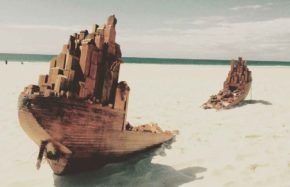THREE FOLLYS

A first impression of a sandcastle on this scale may be that it provides a portal for the imagination. Children are encouraged to explore the interior of the structure and potentially find solace and calm in the world of ideas.
However, this ‘rook’ is also an investigation into the concept of longevity, steeped with references to family, resources and environment. My late father often referred to the construction of his dream ‘Spanish house’ motel in Kerikeri as ‘David’s Folly’, whilst my Grandfather’s family crest consists of a rook-like tower embossed onto a bloodstone and set in a ring as a letter seal.
The material and location of the archetypical sandcastle tends to limit its life-span to a maximum of 12 hours. It is not possible to hold on to a sandcastle and try to preserve it – building a sand castle is an exercise in letting go. In this sense it borders on the sublime, a form of meditation. As a semi-permanent ‘sand castle’, Folly IV captures the purity of the archetype, preserves it, but in doing so also destroys it.
The urge to build these follies springs from an inherited tendency to embark on overzealous projects that may have dangerous side effects or unforeseen outcomes. On one level this ‘folly’ is an allegorical caution about excessive coastal development and exploitation of natural resources. On another level, however, it speaks of the past and the future objects which lie embedded within these resources. Ultimately though, the work’s most important role may simply be to serve as a distraction for young people from the insanely complex adult world.





